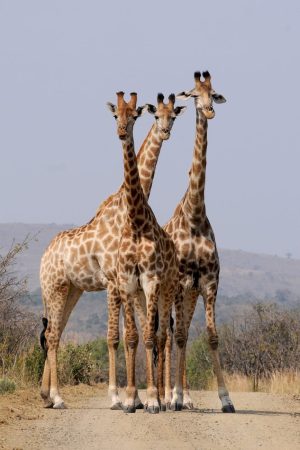Wild animals are fascinating creatures that live in various habitats around the world. Unlike domestic animals, wild animals live in the wilderness, surviving on their instincts and natural surroundings. Understanding these animals is important because they play a crucial role in maintaining the balance of nature. In this hall, we’ll explore over 44 names of wild animals, their habitats, diets, and interesting facts. Whether you’re a student looking to learn more about wildlife or preparing for a school project, this list will help you get started.

List of 44 Names of Wild Animals
Below are 44 Names of Wild Animals, Habitats, Diet and Facts you need to know:
1. Lion
- Habitat: Grasslands and savannas
- Diet: Carnivore (meat-eating)
- Fun Fact: Lions are the only cats that live in groups, called prides.
2. Elephant
- Habitat: Forests and savannas
- Diet: Herbivore (plant-eating)
- Fun Fact: Elephants use their trunks for drinking water and picking up objects.
3. Tiger
- Habitat: Tropical forests, grasslands, and swamps
- Diet: Carnivore
- Fun Fact: Tigers are excellent swimmers and often cool off in lakes and rivers.
4. Giraffe
- Habitat: African savannas
- Diet: Herbivore
- Fun Fact: Giraffes have long necks that allow them to eat leaves from tall trees.
5. Wolf
- Habitat: Forests, tundras, and grasslands
- Diet: Carnivore
- Fun Fact: Wolves communicate with each other using howls, growls, and body language.
6. Leopard
- Habitat: Forests, grasslands, and mountains
- Diet: Carnivore
- Fun Fact: Leopards are strong climbers and often take their prey up into trees.
7. Kangaroo
- Habitat: Australian grasslands and forests
- Diet: Herbivore
- Fun Fact: Kangaroos are known for their strong hind legs, which help them jump great distances.
8. Panda
- Habitat: Bamboo forests in China
- Diet: Herbivore (mainly bamboo)
- Fun Fact: Pandas spend up to 14 hours a day eating bamboo.
9. Cheetah
- Habitat: Grasslands and savannas
- Diet: Carnivore
- Fun Fact: Cheetahs are wild animals and are the fastest land animals, capable of running up to 60-70 mph.
10. Grizzly Bear
- Habitat: Forests, mountains, and tundras
- Diet: Omnivore (eats plants and animals)
- Fun Fact: Grizzly bears can weigh up to 1,000 pounds and have a powerful sense of smell.
11. Penguin
- Habitat: Antarctic and southern coasts
- Diet: Carnivore (mainly fish)
- Fun Fact: Penguins are excellent swimmers and use their wings as flippers to move through water.
12. Zebra
- Habitat: African grasslands
- Diet: Herbivore
- Fun Fact: Each zebra has a unique pattern of black and white stripes.
13. Polar Bear
- Habitat: Arctic regions
- Diet: Carnivore
- Fun Fact: Polar bears are excellent swimmers and primarily hunt seals.
14. Rhinoceros
- Habitat: African and Asian savannas and forests
- Diet: Herbivore
- Fun Fact: Rhinos have thick skin and are known for their large horns.
15. Crocodile
- Habitat: Wetlands, rivers, and lakes
- Diet: Carnivore
- Fun Fact: Crocodiles have been around since the time of dinosaurs and are known for their powerful jaws.
16. Fox
- Habitat: Forests, deserts, and grasslands
- Diet: Omnivore
- Fun Fact: Foxes are highly adaptable and can survive in various environments, including cities.
17. Bison
- Habitat: Grasslands and plains
- Diet: Herbivore
- Fun Fact: Bison are the largest land animals in North America, weighing up to 2,000 pounds.
18. Koala
- Habitat: Eucalyptus forests in Australia
- Diet: Herbivore (eucalyptus leaves)
- Fun Fact: Koalas sleep up to 20 hours a day.
19. Owl
- Habitat: Forests, mountains, and deserts
- Diet: Carnivore
- Fun Fact: Owls can rotate their heads up to 270 degrees.
20. Gorilla
- Habitat: Tropical rainforests
- Diet: Herbivore
- Fun Fact: Gorillas are wild animals and share over 98% of their DNA with humans, making them one of our closest relatives.
21. Jaguar
- Habitat: Rainforests, wetlands, and grasslands
- Diet: Carnivore
- Fun Fact: Jaguars have the strongest bite of all big cats, capable of crushing turtle shells.
22. Hippopotamus
- Habitat: Rivers and lakes in Africa
- Diet: Herbivore
- Fun Fact: Despite their large size, hippos are excellent swimmers and can hold their breath for several minutes underwater.
23. Moose
- Habitat: Forests and wetlands in North America and Europe
- Diet: Herbivore
- Fun Fact: Moose are the largest species of the deer family, with males growing large antlers.
24. Orangutan
- Habitat: Rainforests in Southeast Asia
- Diet: Omnivore (primarily fruits)
- Fun Fact: Orangutans are highly intelligent and use tools to help them gather food.
25. Hyena
- Habitat: African savannas and grasslands
- Diet: Carnivore
- Fun Fact: Hyenas are Wild Animals and are known for their strong jaws and distinctive “laughing” calls.
26. Gazelle
- Habitat: African savannas and grasslands
- Diet: Herbivore
- Fun Fact: Gazelles are known for their speed and agility, able to run at speeds up to 60 mph.
27. Sloth
- Habitat: Tropical rainforests in Central and South America
- Diet: Herbivore
- Fun Fact: Sloths are the slowest mammals, spending most of their time hanging upside down in trees.
28. Arctic Fox
- Habitat: Arctic tundras
- Diet: Omnivore
- Fun Fact: Arctic foxes have thick fur that changes color with the seasons—white in winter and brown in summer.
29. Komodo Dragon
- Habitat: Indonesian islands
- Diet: Carnivore
- Fun Fact: Komodo dragons are the largest lizards in the world, capable of taking down prey as large as a deer.
30. Bald Eagle
- Habitat: Forests, mountains, and coasts in North America
- Diet: Carnivore
- Fun Fact: Bald eagles are known for their incredible eyesight and are the national bird of the United States.
31. Meerkat
- Habitat: Deserts and grasslands in southern Africa
- Diet: Omnivore
- Fun Fact: Meerkats live in large social groups and take turns keeping watch for predators.
32. Chimpanzee
- Habitat: Tropical rainforests and savannas in Africa
- Diet: Omnivore
- Fun Fact: Chimpanzees are our closest living relatives, sharing about 99% of human DNA.
33. Reindeer (Caribou)
- Habitat: Arctic tundra and boreal forests
- Diet: Herbivore
- Fun Fact: Both male and female reindeer grow antlers, which they shed annually.
34. Red Panda
- Habitat: Mountain forests in China and Nepal
- Diet: Herbivore (mainly bamboo)
- Fun Fact: Red pandas are not closely related to giant pandas but share a similar diet and habitat.
35. Vulture
- Habitat: Grasslands, deserts, and mountains
- Diet: Carnivore (scavenger)
- Fun Fact: Vultures have excellent eyesight and can spot carcasses from miles away.
36. Lynx
- Habitat: Forests and mountains in Europe, Asia, and North America
- Diet: Carnivore
- Fun Fact: Lynx are known for their sharp vision and distinctive tufted ears.
37. Wolverine
- Habitat: Boreal forests and tundras
- Diet: Omnivore
- Fun Fact: Wolverines are fierce and strong, capable of taking down prey much larger than themselves.
38. Flamingo
- Habitat: Wetlands, lagoons, and lakes
- Diet: Omnivore (mainly algae and small aquatic animals)
- Fun Fact: Flamingos get their pink color from the carotenoid pigments in their food.
39. Capybara
- Habitat: Wetlands and forests in South America
- Diet: Herbivore
- Fun Fact: Capybaras are the largest rodents in the world and are highly social animals.
40. Iguana
- Habitat: Rainforests and tropical regions in Central and South America
- Diet: Herbivore
- Fun Fact: Iguanas are excellent climbers and can drop from great heights to escape predators.
41. Mountain Gorilla
- Habitat: Rainforests in Central Africa
- Diet: Herbivore
- Fun Fact: Mountain gorillas are critically endangered and are one of the few primate species that build nests to sleep in.
42. Saiga Antelope
- Habitat: Steppes and semi-deserts in Central Asia
- Diet: Herbivore
- Fun Fact: Saiga antelopes are easily recognized by their large, bulbous noses, which help filter dust and regulate body temperature
43. Peacock
- Habitat: Forests and grasslands in South Asia
- Diet: Omnivore
- Fun Fact: Male peacocks are known for their beautiful, colorful tail feathers, which they use in courtship displays.
44. African Wild Dog
- Habitat: African savannas, woodlands, and grasslands
- Diet: Carnivore
- Fun Fact: African wild dogs are highly social and hunt in packs, known for their teamwork and efficiency in hunting.
SEE RELATED ARTICLES
- Names of aquatic animals, habitats and adaptations
- Domestic Animals, Names and their roles
- Types Of ruminant animals, definition and uses
Conclusion on the 44 names of Wild Animals, Habitats, diet and facts
Learning about wild animals helps us appreciate the diversity of life on Earth. These creatures are essential to their ecosystems, and by understanding them, we become better stewards of the environment. Next time you visit a zoo or watch a wildlife documentary, you’ll have a deeper understanding of these amazing animals!
